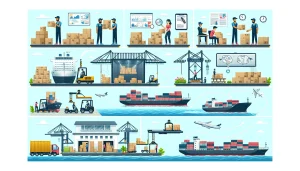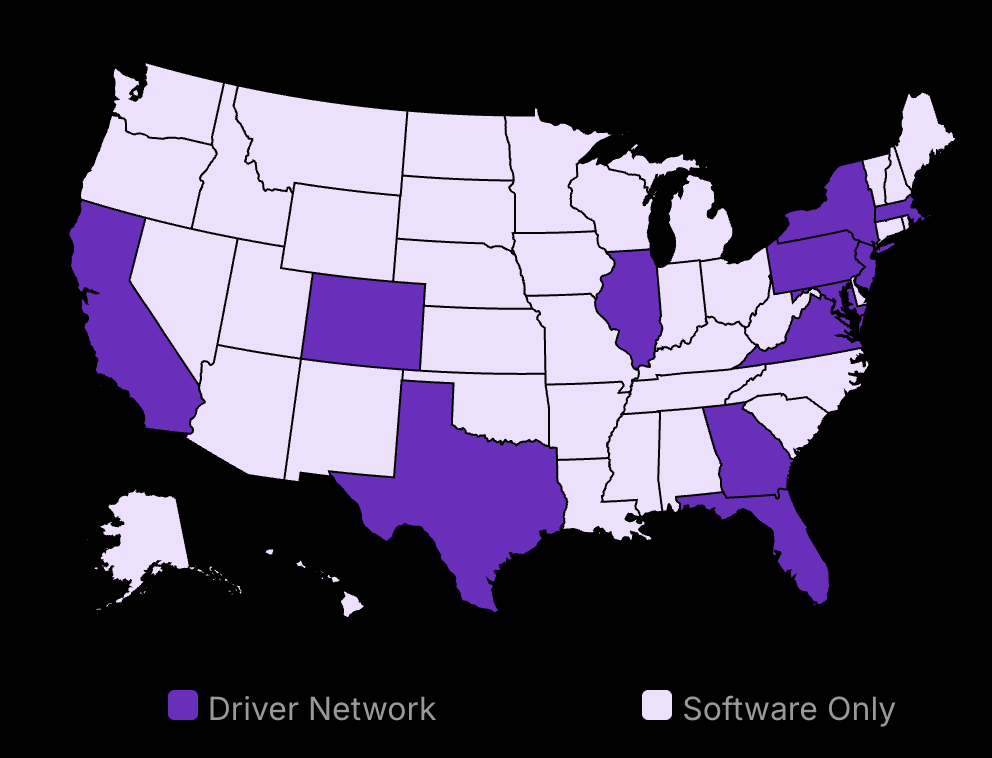Labor costs can make or break a retail business. In 2024, with rising minimum wages and fierce competition, it’s crucial to understand the average labor costs in your industry.
This comprehensive guide breaks down benchmarks for labor cost in retail sector, store size, and location. You’ll learn how to calculate your optimal labor cost percentage and discover proven strategies to optimize your workforce without sacrificing customer experience.
From leveraging technology to cross-training employees, we’ll explore the most effective ways to keep your labor costs under control. Plus, we’ll dive into the latest trends shaping the future of retail labor, including e-commerce, flexible staffing, and automation.
Ready to take control of your retail labor costs? Let’s get started.
Labor Costs Heat Up:
In the first quarter of 2024, labor costs in the U.S. increased by 1.2%, exceeding the forecasted 1.0% rise.

Save 80% of delivery management time
We handle everything:
- Dedicated operations manager
- Real-time tracking dashboard
- Automated customer notifications
- Urgent issue resolution
How Much Should You Budget for Retail Labor Costs in 2024?
Retail Labor Cost Benchmarks by Industry
In 2024, the average labor costs as a percentage of sales varied significantly across different retail sectors. For fashion retailers, labor costs typically ranged from 10% to 20% of sales, with higher-end stores often having higher percentages due to the need for more experienced and knowledgeable sales associates. Grocery stores, on the other hand, had lower labor costs, as many positions require less specialized skills.
Labor is the Biggest Expense for Top Grocers:
Labor is the biggest component of total SGA costs for 10 of the largest U.S. grocers, estimated at 14% of sales on average.
Electronics retailers saw labor costs ranging from 12% to 18% of sales, as these stores often require sales staff with technical knowledge to assist customers.
Store size also played a role in labor cost percentages. Small retailers, with annual sales under $5 million, often had higher labor costs, ranging from 15% to 25% of sales, due to the need for a minimum number of staff to keep the store running effectively. Medium-sized retailers, with annual sales between $5 million and $50 million, typically had labor costs between 12% and 20% of sales. Large retailers, with annual sales over $50 million, benefited from economies of scale and had lower labor costs, usually ranging from 8% to 15% of sales.
Impact of Store Location and Regional Factors
Regional factors and store location also impacted labor costs in 2024. Retailers in urban areas with higher costs of living often had to pay higher wages to attract and retain employees, resulting in higher labor cost percentages. Stores in rural areas, where the cost of living is lower, could often maintain lower labor costs.
Calculating Your Optimal Labor Cost Percentage
To determine your store’s ideal labor cost percentage in 2024, you need to consider several factors. First, analyze your store’s size and sales volume. As a general rule, larger stores with higher sales volumes can maintain lower labor cost percentages due to increased efficiency and economies of scale. Additionally, retailers should consider the logistics of their operations, especially in urban areas where on-demand services can enhance efficiency. For instance, utilizing a reliable courier service in Boston can help streamline deliveries and optimize inventory management, further reducing unnecessary labor costs.
Next, assess your employees’ productivity. Stores with highly productive employees can often operate with lower labor cost percentages, as they require fewer staff members to achieve the same sales volume. To further calculate labor cost percentage by employee productivity, divide your store’s total sales by the number of labor hours worked.
Wholesale Productivity:
According to US Bureau of Labor, labor productivity declined 1.6% in wholesale trade and rose 1.6% in retail trade in 2023.
Once you have analyzed your store’s size, sales volume, and employee productivity, you can determine your optimal labor cost percentage. As a starting point to calculate labor costs, aim for a percentage that falls within the industry benchmarks for your retail sector and store size. Then, adjust this percentage based on your specific store’s characteristics and goals.
In metropolitan areas, seamless logistics and efficient delivery are paramount for retail success. Leveraging a reliable courier service in New York City can enhance operational efficiency, allowing retailers to meet customer demands promptly and optimize labor costs significantly.
Food and Beverage Workers Hourly Wages Slowly Rise Since 2010:
Hourly earnings for nonsupervisory food and beverage store employees have gone up about 1% every year since 2010.
Adjusting Labor Costs Based on Seasonality
Retailers should also consider adjusting their labor costs based on seasonality and peak shopping periods. During busy times, such as the holiday season, you may need to increase your staff to meet customer demand, resulting in temporarily higher labor cost percentages. However, during slower periods, you can reduce staff hours to maintain a lower labor cost percentage.
To effectively manage labor costs and seasonal fluctuations, create a staffing plan that aligns with your projected sales volume for each period. This will help you optimize your labor costs throughout the year while ensuring you have sufficient staff to provide excellent customer service. Consider partnering with an efficient logistics solution to enhance your delivery capabilities. Utilizing a reliable delivery service in Atlanta can streamline your operations and allow you to focus on core business activities while ensuring timely deliveries for your customers.
Key Factors Affecting Retail Labor Costs in 2024
Wage Stuck Since 2009:
The federal minimum wage in the U.S. has remained at $7.25 an hour since 2009, despite calls to raise it to $15.
Minimum Wage Increases and Their Impact on Retailers
Minimum wage hikes have a direct impact on retail labor costs. In recent years, many states and cities have implemented incremental increases to their minimum wage rates.
Minimum Wage on the Rise in Many States:
As of 2016, 25 states and the District of Columbia had minimum wages above the federal level, with plans for further increases in many of them.
Retailers must adapt to these changes to remain compliant and competitive. Some strategies for calculating labor costs and absorbing increased labor costs include:
Optimizing Scheduling and Staffing
Retailers can use data-driven scheduling software to ensure optimal staffing levels based on historical sales data and real-time traffic. This approach minimizes overstaffing during slow periods and ensures adequate coverage during peak hours.
Implementing Cross-Training Programs
Cross-training employees to handle multiple roles can increase efficiency and reduce the need for additional hires. By investing in employee development, retailers can create a more versatile workforce that can adapt to changing demands.
The Role of Employee Benefits in Total Labor Costs
In addition to wages, employee benefits contribute significantly to overall labor costs. Common benefits offered by retailers include:
-
Health insurance
-
Paid time off (vacation, sick days, personal days)
-
Retirement plans (401(k), pension)
-
Employee discounts
-
Tuition reimbursement
Offering a competitive benefits package can help attract and retain top talent, reducing turnover costs. However, these benefits come at a price. Employers must carefully weigh the costs and benefits of each offering to determine the optimal mix for their business.
Cost-Benefit Analysis of Employee Benefits
Conducting a thorough cost-benefit analysis can help retailers make informed decisions about their benefits packages. Factors to consider include:
-
Industry benchmarks for benefits offerings
-
Employee preferences and needs
-
Impact on recruitment and retention
-
Long-term cost savings from reduced turnover
According to the Bureau of Labor Statistics, employee wages and salaries account for about 70.5% of total compensation costs, while benefits make up the remaining 29.5%.
Creative Ways to Provide Employee Perks
While traditional benefits can be costly, retailers can also offer creative perks that boost employee morale and retention without breaking the bank. Some examples include:
-
Flexible scheduling options
-
Recognition programs (employee of the month, spot bonuses)
-
Professional development opportunities (workshops, mentorship programs)
-
Wellness initiatives (gym memberships, healthy snacks)
By thinking outside the box, retailers can create a positive work environment that attracts and retains top talent while managing labor costs effectively.
Balancing Labor Costs and Customer Experience
Retailers must strike a delicate balance between managing labor costs and maintaining a high-quality customer experience. Understaffing can lead to long lines, poor service, and frustrated customers, while overstaffing can see turnover rates eat into profits.
To find the right balance, retailers should:
-
Monitor key performance indicators (KPIs) such as sales per, restaurant labor cost per hour and customer satisfaction scores
-
Invest in technology solutions that streamline operations and reduce labor needs (e.g., self-checkout kiosks, inventory management systems)
-
Continuously assess and adjust staffing levels based on data-driven insights
By taking a proactive approach to managing labor costs while prioritizing customer experience, retailers can position themselves for long-term success in an increasingly competitive market.
What is a Reasonable Cost for Labor in Retail?
The appropriate labor cost percentage varies by retail sector and business model. However, a general rule of thumb is to try to hold payroll to no more than 12% of sales. If a retailer is doing that, then they their annual costs are on par with major national retail chains. For example, if a retail store generates $350,000 in annual sales, its labor costs should ideally fall around $60,000.
It’s important to note that while keeping labor costs in check is crucial for profitability, retailers should not compromise on staffing levels to the point where customer service suffers. Striking the right balance requires ongoing monitoring, analysis, and adjustment based on sales data and customer feedback.
Proven Strategies for Optimizing Retail Labor Costs
Leveraging Technology to Streamline Labor Management
Labor management software has become an essential tool for retailers looking to optimize their workforce and reduce costs. These systems provide real-time data on employee performance, scheduling, and attendance, allowing managers to make informed decisions and adjust staffing levels based on customer demand.
By utilizing data analytics, retailers can identify peak sales periods, customer traffic patterns, and other key metrics that impact labor requirements. This information can be used to create more efficient schedules, thereby reducing labor costs by overstaffing during slow periods and ensuring adequate coverage during busy times. For example, a retail chain may use predictive analytics to forecast customer traffic for the upcoming week, adjusting employee schedules accordingly to minimize labor costs while maintaining optimal service levels.
Best Practices for Implementing Labor Management Technology
-
Choose a user-friendly system that integrates with existing HR and POS software
-
Train managers and employees on how to use the system effectively
-
Set clear performance metrics and goals for each role and department
-
Regularly review and analyze labor data to identify opportunities for improvement
-
Communicate schedule changes and staffing decisions to employees in a timely manner
Cross-Training Employees to Maximize Productivity
Cross-training involves teaching employees to perform multiple roles and responsibilities within the organization. By equipping staff with a broader skill set, retailers can improve productivity, reduce labor costs, and enhance overall customer service.
When employees are cross-trained, they can easily step in to cover shifts or assist in other departments during peak periods, reducing the need for additional hiring or overtime. This flexibility also allows retailers to operate with a leaner workforce, as each employee can contribute to multiple aspects of the business.
Moreover, cross-training can improve employee engagement and job satisfaction by providing opportunities for growth and development. As employees acquire new skills and take on more responsibilities, they may feel more valued and invested in the company’s success.
Implementing a Successful Cross-Training Program
-
Identify key roles and responsibilities that would benefit from cross-training
-
Develop a structured training program that covers essential skills and knowledge for each role
-
Pair experienced employees with trainees to provide hands-on guidance and mentorship
-
Offer incentives or recognition for employees who successfully complete cross-training
-
Regularly assess the effectiveness of the cross-training program and make adjustments as needed
What is a Normal Labor Cost in Retail?
Labor costs in the retail industry can vary significantly depending on factors such as the type of retail business, location, and staffing model. However, as a general guideline, a healthy labor cost percentage for most retailers falls between 20% and 30% of total sales.
For example, if a retail store generates $100,000 in monthly sales, a normal labor cost would range from $20,000 to $30,000. This includes wages, benefits, and payroll taxes for all employees, including full-time, part-time, and seasonal workers.
It’s important to note that labor cost percentages can be higher for certain types of retailers, such as specialty stores or those offering personalized services. In these cases, labor costs may account for up to 40% or more of total sales, as the customer experience heavily relies on knowledgeable and attentive staff.
To determine a reasonable labor cost for your specific retail business, consider the following factors:
-
Industry benchmarks and competitor analysis
-
Desired level of customer service and support
-
Store layout and size
-
Product mix and complexity
-
Local labor market and minimum wage requirements
What is indirect labor costs?
Direct cut labor costs and indirect labor costs impact retail businesses differently, but both are crucial for understanding total labor costs. Direct labor costs cover employee wages for those directly producing goods or services, while indirect labor costs support overall operations. Indirect costs include expenses for management, administrative staff, and maintenance workers who don’t directly contribute to production but are essential for the business.
Indirect labor costs encompass:
-
Management salaries
-
Administrative payroll
-
Employee benefits for support staff
-
Training expenses
-
HR department costs
These are typically considered overhead and can be harder to allocate to specific products compared to direct labor costs. Managing both direct costs and indirect labor costs is crucial for controlling expenses, maintaining profit margins, and ensuring the long-term success of retail businesses.
By implementing these proven strategies and understanding what constitutes a normal labor cost in the retail and restaurant industry itself, businesses can effectively optimize their workforce, reduce expenses, and improve overall profitability.
Retail Labor Cost Trends to Watch in 2024 and Beyond
The Growing Influence of E-Commerce on Retail Labor
The rapid growth of e-commerce in recent years has had a profound impact on the retail industry, and this trend shows no signs of slowing down. In 2022, online sales continued to soar, with the U.S. Census Bureau reporting a 14.2% increase in e-commerce sales compared to the previous year. This shift towards online shopping has led retailers to reevaluate their labor strategies, seeking to strike a balance between in-store employee hours and e-commerce staffing needs.
As we move further into 2024, retailers will need to adapt their labor allocation to accommodate the growing demand for online shopping while still maintaining a strong in-store presence. This may involve investing in training programs to equip employees with the skills needed to handle both online and in-store tasks, such as order fulfillment, customer service, and inventory management.
Looking ahead, experts predict that the rise of e-commerce will continue to impact retail labor costs. A recent study by Forrester Research suggests that by 2025, online sales will account for 25% of total retail sales in the U.S., up from 18% in 2022. As a result, retailers will need to allocate a larger portion of their labor budgets to e-commerce-related tasks, such as order fulfillment, customer service, and digital marketing.
The Emergence of Flexible Staffing Models
In response to the evolving retail landscape, many companies are embracing flexible staffing models to optimize labor costs and adapt to fluctuating demand. These models include part-time, seasonal, and gig workers, allowing retailers to scale their workforce up or down as needed.
The benefits of flexible staffing are clear: reduced labor costs, increased adaptability, and the ability to tap into a wider talent pool. However, managing a diverse workforce with varying schedules and commitments can present challenges, such as maintaining consistent training and ensuring seamless communication.
To successfully incorporate flexible staffing into their labor strategy, retailers should:
Develop clear communication channels
Ensure that all employees, regardless of their work arrangement, have access to the information and resources they need to perform their roles effectively.
Invest in training and development
Provide ongoing training opportunities to help flexible staff acquire the skills needed to succeed in their roles and contribute to the company’s overall goals.
Foster a sense of belonging
Create an inclusive work environment that values the contributions of all employees, regardless of their work arrangement, to maintain high levels of engagement and for employee retention.
The Future of Retail Automation and Its Impact on Labor Costs
Automation technology has been gaining traction in the retail industry, with companies exploring ways to streamline tasks and drastically reduce labor costs. Self-checkout kiosks, inventory robots, and AI-powered chatbots are just a few examples of how automation is transforming the retail landscape.
Implementing automation in retail can lead to significant cost savings and efficiency gains. For example, a study by McKinsey & Company found that automated checkout systems can reduce checkout times by up to 50%, while inventory robots can help retailers optimize stock levels and reduce out-of-stocks by up to 30%.
However, it’s essential to balance the benefits of automation with the importance of human interaction in retail. Customers still value the personal touch and expertise that human employees provide, particularly when it comes to complex purchases or problem-solving.
As retailers navigate the future of automation, they should:
Identify tasks that are well-suited for automation
Focus on automating repetitive, time-consuming tasks that don’t require human judgment or empathy, such as inventory tracking or basic customer inquiries.
Invest in employee training and development
As automation takes over certain tasks, retailers should invest in training programs to help employees acquire the skills needed to work alongside technology and provide high-value, personalized service to customers.
Prioritize the customer experience
When implementing automation, always keep the customer experience at the forefront. Use technology to enhance, rather than replace, human interaction, and ensure that customers have easy access to human support when needed.
Regarding the question “What is the average labor cost to sales?”, it’s important to note that labor cost percentages vary widely across different retail sectors. According to the National Retail Federation, the average labor cost to sales ratio in the U.S. retail industry is around 10-15%. However, this can range from as low as 5% for some high-volume, low-margin retailers to as high as 25% for specialty retailers with high-touch customer service models.
As retailers navigate the evolving landscape of labor costs in 2024 and beyond, it will be crucial to stay attuned to industry trends, embrace flexibility, and strike a balance between automation and human interaction. By doing so, companies can optimize their labor strategies, reduce costs, and deliver exceptional customer experiences in an increasingly competitive market.
Navigating Retail Labor Costs: Your Roadmap to Success
Retail labor costs are a complex landscape, influenced by factors like industry benchmarks, minimum wage increases, employee benefits, and emerging trends. By understanding these key drivers and implementing proven strategies, you can optimize your labor costs without sacrificing profitability or employee satisfaction.
As you move forward, consider leveraging technology to streamline labor management, cross-training employees to maximize productivity, and exploring flexible staffing models to adapt to changing market conditions. Stay attuned to the growing influence of e-commerce and the potential impact of automation on your labor strategy.
Are you ready to take control of your retail labor costs in 2024? Start by calculating your optimal labor cost percentage and developing a tailored plan that aligns with your business goals. With the right approach, you can navigate the challenges ahead and position your retail business for long-term success.


























